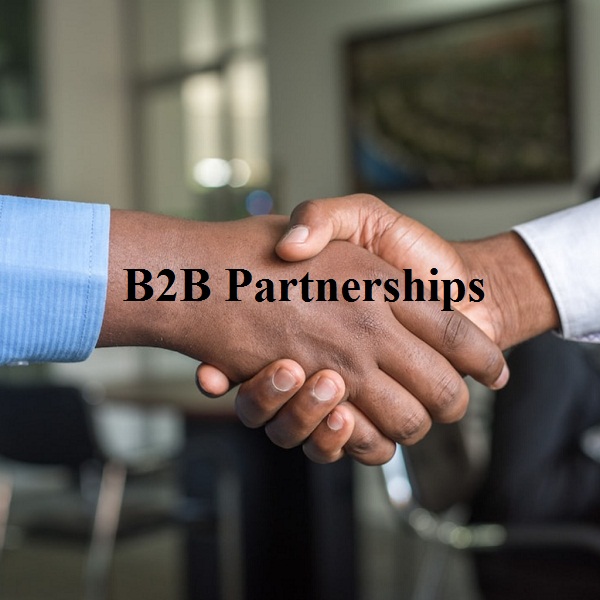B2B partnerships, or business-to-business partnerships, refer to collaborative relationships between two or more businesses that work together to achieve common goals. These partnerships are formed for a variety of reasons, including to expand market reach, reduce costs, gain access to new technologies or expertise, or increase revenue.
From analyzing the market and competitors to road mapping, here’s how to get the most out of your B2B partnerships with maximum results.
To step into B2B, analyzed the market and competitors, highlighted the strengths of your products, identified the pains of potential partners, decentralized the marketing department and identified a B2B department.
Here are some notes that guided us in our successful B2B rollout.
What are the key features of B2B partnerships?
• A limited contact pool: In B2B, the number of possible partners is often limited, and the more complex your niche, the fewer potential partnerships you will find. For this reason, you will need to learn how to work especially well with those who are already interacting with you or who are present on the market.
• Endurance: Companies seek stable partners for the long term, especially in specific industries, so searches are approached thoroughly. If you provide a quality product, your partner will not be interested in third-party offers, and you will likely develop side-by-side for years.
• A potential partner could be the expert in your industry: In B2B, cooperation is not based on personal preferences or rash decisions. You will need to prove the value of your product or service step by step. For example, my company has partners who know their markets and industry trends well but still need a high-quality online platform to operate — or vice versa. Your potential partner could have ready-made operations and technologies but without a bright, well-developed brand.
• The decision-making process takes longer: It can be months before you start cooperating, and during that time you need to remind a partner about your product and the value a partnership will bring.
• The need for delegation of authorities and duties: You will need internal experts who know the industry, your product, the business models of potential partners and the challenges you may face in the future.
• Strategy: Any B2B partnership should have a plan to track the results of the collaboration.
How to find B2B partnerships
Search channels for partners are highly dependent on the industry. These include LinkedIn pages, thematic forums and business platforms, etc. It could also be the result of implementing digital and content marketing tools. To this list, you can add conferences, symposiums and events organized by industry media. In any case, the primary purpose of these activities is to find decision-makers.
In B2C, customers are often driven by emotions and make decisions on impulse because it is no big deal to spend money when it is not critical. In B2B, however, the price can amount to millions, and further business development depends on partnerships, so decisions are made cautiously. The number of decision-makers is also increasing, so be prepared to showcase your product strengths from different angles, depending on the expertise of whomever you are addressing.
The virtue of research
Before starting communication activities, create a portrait of a partner that best suits the business objectives. The next step is to study the sample of potential customers and filter it based on the necessary criteria. The goal is to arrive at a list of the top 10 or 50, depending on the niche of the business and the number of potential partners. Working with a small segmented list will bring more value than a broad unfiltered audience.
This approach also fits super-complex niches: we analyze all potential customers and evaluate compliance with the portrait of our ideal partner. Based on the results, we compile a top Х with a brief description of the main aspects of interest.
The next step is to add each possible partner to the database, collect data about the company and its turnover and look for all available information. This will remove unpromising options, leaving only the target audience. Another advantage of this approach is that you’ll learn many details about potential partners in the process, which will help identify decision-makers, set up contacts and develop a cooperation strategy.
The importance of in-person meetings
We live in an online world. Hundreds of employees at my company work productively from different parts of the world, meeting only on online calls. But to build long-term B2B relationships, it’s essential to meet partners in person, especially in a semi-formal setting because one personal meeting works better than five perfect commercial proposals, which the manager will send your partners by mail.
Know your partner’s end customers
It’s a big mistake if a B2B company doesn’t know its partners’ end customers — those who directly use the product or service resulting from your cooperation. And if your offer has any issues or is underdeveloped, you will find out about it from them.
Our expertise in product development is based on almost 30 years of experience in the entertainment industry. We know the end customers of our services because the teams interview them regularly: We know what they like, what interests them and what they appreciate about our products. To increase demand, we develop new product features, for which we are simultaneously developing the platform’s functionality.
Knowledge of end customers and experience interacting with them will give you an additional competitive advantage.
Why you need a B2B department
A dedicated B2B department’s primary functions are communicating with partners, presenting product and development strategies and building cooperation with internal departments, and it deals with operations ranging from strategy to lead generation. The main activity of this team is communication… lots of communication.
To close one particular deal, a B2B manager must work with representatives from different departments and several decision-makers. Sometimes, companies hire third-party B2B teams because their marketing department doesn’t have enough time, resources or experience to build B2B interactions with partners competently. These teams create the strategy, prepare a detailed roadmap and are sometimes involved in its implementation.
What a B2B manager will need to do
Among the many critical tasks of this managerial role is diving into the specifics of several products and projects at the same time, including:
- Looking for those business functions that potential partners cannot maintain themselves.
- Understanding the specifics of the industry and the desires of end customers.
- Building communication with partners and between company departments.
- Creating a transparent offer (including a partnership strategy) and presenting it to decision-makers.
What can you consider a ready-to-go strategy?
The ready-to-go strategy is a step-by-step guide to action for the long-term partnership. Your strategy could consider delegating some points to your partner, to be implemented together or by your company only.
- Gathered studies: Carried out for partnership strategy, which may include market analysis, partner business performance indicators and your offer.
- A complete presentation: This can be a 200-slide “mother presentation” from which the B2B department managers will choose the main slides relevant to each decision-maker. (You will likely use the entire presentation for internal use only.)
- A project roadmap: A detailed development plan describing all crucial milestones.
- Price: This should also be included in your project roadmap — the partner must understand exactly what steps are involved and how much it will cost.
The strategy shouldn’t be just a regular document — it should consist of streamlined processes, budget assessments, presentations and accompanying documents.
Final words
If you step into B2B, there is still a possibility that you will spend millions on building your brand and won’t get the results you expected. An issue here could be the difference between B2B and B2C: businesses don’t close deals based on subjective preferences or emotions, as it could be in B2C.
B2B customers should be offered something they cannot produce on their own. It is crucial to initially find out the client’s actual goals and ensure maximum transparency of your offer.
Source: entrepreneur










